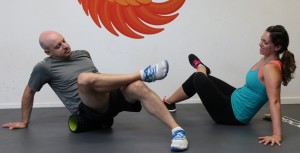Note: This was originally published on my old blog on 3/14/2016
Coach Jean, I’ve been seeing people rolling around at my gym and my friend told me lacrosse balls are great for working out knots in the back. Does this stuff really work?
Quick Summary
Although further research is needed, some studies indicate that foam rolling is helpful as a warm up and/or post workout recovery to prevent soreness. How and why it works is still not totally understood.
Background
Well, with that glowing recommendation, I bet you can’t wait to get started!
In all seriousness though, it’s important to remember that there’s a difference between something that works well for you and something being well-researched.
The technical term for foam rolling and using a lacrosse ball is self-myofascial release (abbreviated as SMR). SMR means you are releasing fascia (connective tissue) on your own, rather than massage therapist doing it for you.
The fact is, SMR isn’t well researched. There are a handful of studies and some of these indicate it helps with range of motion (a joint’s ability to move freely) without reducing performance. Static stretching, on the other hand, has sometimes shown to reduce power and performance, so many athletes and coaches use foam rolling rather than static stretching as a warm up.
In addition, some SMR studies show a reduction in soreness after a workout (although it’s still not clear why, exactly).
How to Start
The easiest way to remember a SMR routine is to work from the ground up.
Feet
- With a lacrosse ball, roll the bottoms of your feet, especially the arch.
- Breathe through any areas of extra intensity and try pressing in one spot while spreading and curling your toes.
Calves
- Sit on your bottom with legs extended in front of you.
- Keeping your feet relaxed, work your way up your calves from the Achilles/ankle area to the back of the knee.
- For extra intensity, stack one leg on top of the other, and/or lift your bottom off the ground.
- In extra intense spots, try pinning your leg and rolling your foot and ankle, drawing a circle with your toes.
Glutes
- Sit with one “cheek” on the lacrosse ball, holding some of your weight with your hands and opposite foot.
- Perform 10 “clamshells” on the working side.
Upper back
- Lie with your upper back on the roller, hands behind your head, supporting your neck.
- Lift your hips off the ground and use your legs to roll forward and back, from your shoulders to the mid, almost lower back.
Top Tips for Success
- These are the top 4 areas; you can use the foam roller and lacrosse ball on any fleshy area (avoid bony joints and areas). See resources below for some books and websites.
- Try other tools, like the rumble roller, softballs, make a t-spine rollers with your lacrosse ball, and more.
Resources
NOTE: Always consult your physician first if you are experience ongoing muscular or join pain.
As you look at the resources, keep in mind these methods may be helpful for you, but they are by no means “miracles” or “cure-alls” to your ailments and pain. . The people selling these resources are businesses and use a lot of hyperbole to sell their products – take it all with a grain of salt.
- Trigger Point Performance (SMR tools and videos): https://www.tptherapy.com/; YouTube channel: https://www.youtube.com/user/tptherapy
- Trigger Point Therapy Workbook: http://www.triggerpointbook.com/
- Kelley Starrett’s Mobility Workout of the Day (MWOD) website and Supple Leopard book: http://www.mobilitywod.com/the-supple-leopard/ ; YouTube channel: https://www.youtube.com/user/sanfranciscocrossfit
- MELT Method: https://www.meltmethod.com/
- Sources
- http://www.ncbi.nlm.nih.gov/pubmed/23588488
- http://www.ncbi.nlm.nih.gov/pubmed/22580977
- http://www.ncbi.nlm.nih.gov/pubmed/?term=self-myofascial+release
- http://www.ncbi.nlm.nih.gov/pubmed/26562930
- http://www.ncbi.nlm.nih.gov/pubmed/26592233
- http://www.ncbi.nlm.nih.gov/pubmed/26118527
- http://www.ncbi.nlm.nih.gov/pubmed/25968853
- http://www.ncbi.nlm.nih.gov/pubmed/25883869
- http://www.ncbi.nlm.nih.gov/pubmed/23772339
- http://www.strengthandconditioningresearch.com/foam-rolling-self-myofascial-release/
- http://breakingmuscle.com/mobility-recovery/science-says-foam-rolling-increases-rom-and-does-not-decrease-strength
